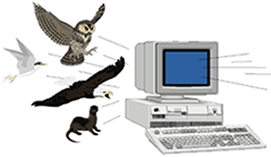- Home
- About S&T
- Taxa/Organisms
- Ecosystems
- Issues
- Methods & Tools
- Reports & Publications
- Location
- Search
Publisher: USGS | Science Center: Columbia Environmental Research Center (CERC, Columbia) | Format: URL
www.cerc.usgs.gov — The BFRS works cooperatively with team members from CERC and with faculty and graduate students of Department of Wildlife and Fisheries Sciences at Texas A&M University in research areas represented by the branch structure of the CERC including toxicology, ecology, biochemistry and physiology, environmental chemistry, ecogeography, and information More...

Publisher: USGS | Science Center: Patuxent Wildlife Research Center (PWRC, Laurel) | Format: URL
www.pwrc.usgs.gov — Information about ecotoxicological exposure and its effects on terrestrial vertebrates residing in estuarine and coastal habitats like the Atlantic, Gulf and Pacific Coasts, Alaska and Hawaii, as well as the Great Lakes. These vertebrates include birds, mammals, amphibians and reptiles. The data is a compilation of results from computerized More...

Publisher: USGS | Science Center: Forest and Rangeland Ecosystem Science Center (FRESC, Corvallis) | Format: URL
fresc.usgs.gov — Prescribed fire and forest thinning is a management strategy that promotes the development of forest structure and composition similar to that present under a native fire regime. This research summary describes how FRESC researchers will address the effects of prescribed fire and forest thinning on the diversity, abundance, and habitat More...

Publisher: USGS | Science Center: Western Ecological Research Center (WERC, Sacramento) | Format: URL
www.werc.usgs.gov — Native amphibian and reptile populations worldwide are under threat from exotic invasive species of plants and animals, including other reptiles and amphibians. As habitats are changed and plant community organization is modified by exotic species, delicate relationships between plants and animals are altered or eliminated, creating a negative More...

Publisher: USGS | Science Center: Patuxent Wildlife Research Center (PWRC, Laurel) | Format: URL
www.pwrc.usgs.gov — Written summaries of biological characteristics and contaminant exposure and effects data for 38 coastal and estuarine terrestrial vertebrates are available. Species were selected based on their previous use in contaminant monitoring, their status as valued natural resources, or as representatives of taxonomic groups. Characterizations were More...

Publisher: USGS | Science Center: Columbia Environmental Research Center (CERC, Columbia) | Format: URL
www.cerc.usgs.gov — This project identifies, studies, and evaluate scontaminant-wildlife problems where the viability of populations is thought to be at risk, particularly wildlife fauna of the Texas-New Mexico region, emphasizing research on amphibians, reptiles, birds and bats.

Publisher: USGS | Science Center: Forest and Rangeland Ecosystem Science Center (FRESC, Corvallis) | Format: URL
fresc.usgs.gov — Description of a project to determine the status of reptiles and amphibians at Olympic National Park. Includes project objectives, metadata, related publications, and contact information.

Publisher: USGS | Science Center: Forest and Rangeland Ecosystem Science Center (FRESC, Corvallis) | Format: URL
fresc.usgs.gov — There is a relatively rich herpetofauna in southwestern Oregon with about 38 species present. These species are almost equally divided between amphibians and reptiles. The objective of this issue overview is to conduct field surveys and assess status of several amphibian species of management concern, including: Western toad (Bufo boreas), Cascade More...

Publisher: USGS | Science Center: Western Ecological Research Center (WERC, Sacramento) | Format: URL
www.werc.usgs.gov — This site is a field guide to the reptiles and amphibians of coastal Southern California, including species accounts, illustrations of tadpoles, and images of different habitat types. The guide also contains a glossary of terms, a map of the study area, and types of habitats.

Publisher: USGS | Science Center: Forest and Rangeland Ecosystem Science Center (FRESC, Corvallis) | Format: URL
fresc.usgs.gov — An overview of research that defines the distribution and habitat requirements of amphibians and reptiles in southern Oregon, mostly in old-growth forests or alpine habitats. Includes links to USGS publications resulting from this research.
